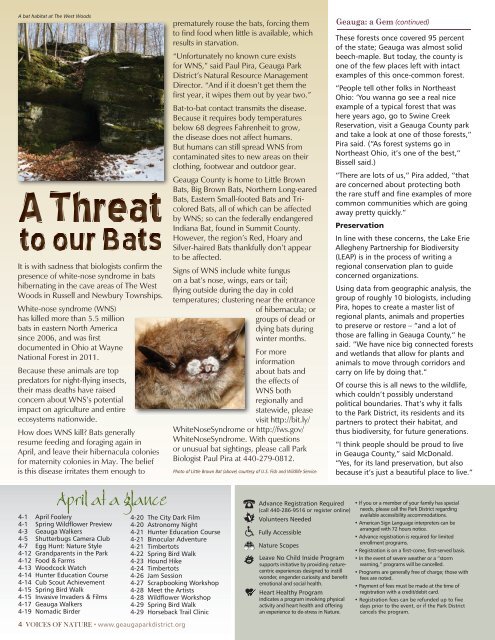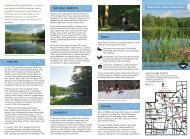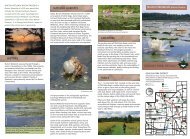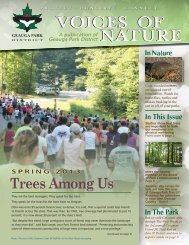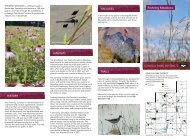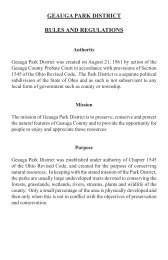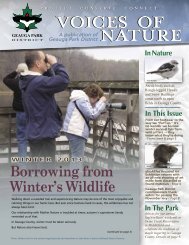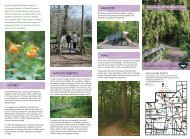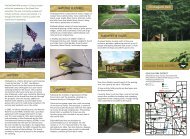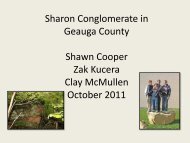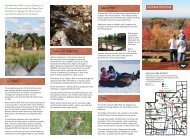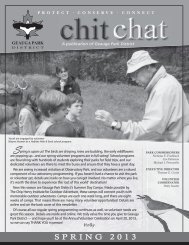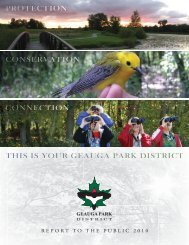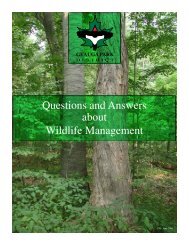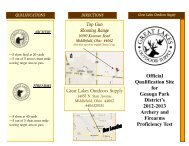What Makes Geauga a Gem - Geauga Park District
What Makes Geauga a Gem - Geauga Park District
What Makes Geauga a Gem - Geauga Park District
You also want an ePaper? Increase the reach of your titles
YUMPU automatically turns print PDFs into web optimized ePapers that Google loves.
A bat habitat at The West Woods<br />
It is with sadness that biologists confirm the<br />
presence of white-nose syndrome in bats<br />
hibernating in the cave areas of The West<br />
Woods in Russell and Newbury Townships.<br />
White-nose syndrome (WNS)<br />
has killed more than 5.5 million<br />
bats in eastern North America<br />
since 2006, and was first<br />
documented in Ohio at Wayne<br />
National Forest in 2011.<br />
Because these animals are top<br />
predators for night-flying insects,<br />
their mass deaths have raised<br />
concern about WNS’s potential<br />
impact on agriculture and entire<br />
ecosystems nationwide.<br />
How does WNS kill Bats generally<br />
resume feeding and foraging again in<br />
April, and leave their hibernacula colonies<br />
for maternity colonies in May. The belief<br />
is this disease irritates them enough to<br />
prematurely rouse the bats, forcing them<br />
to find food when little is available, which<br />
results in starvation.<br />
“Unfortunately no known cure exists<br />
for WNS,” said Paul Pira, <strong>Geauga</strong> <strong>Park</strong><br />
<strong>District</strong>’s Natural Resource Management<br />
Director. “And if it doesn’t get them the<br />
first year, it wipes them out by year two.”<br />
Bat-to-bat contact transmits the disease.<br />
Because it requires body temperatures<br />
below 68 degrees Fahrenheit to grow,<br />
the disease does not affect humans.<br />
But humans can still spread WNS from<br />
contaminated sites to new areas on their<br />
clothing, footwear and outdoor gear.<br />
<strong>Geauga</strong> County is home to Little Brown<br />
Bats, Big Brown Bats, Northern Long-eared<br />
Bats, Eastern Small-footed Bats and Tricolored<br />
Bats, all of which can be affected<br />
by WNS; so can the federally endangered<br />
Indiana Bat, found in Summit County.<br />
However, the region’s Red, Hoary and<br />
Silver-haired Bats thankfully don’t appear<br />
to be affected.<br />
Signs of WNS include white fungus<br />
on a bat's nose, wings, ears or tail;<br />
flying outside during the day in cold<br />
temperatures; clustering near the entrance<br />
of hibernacula; or<br />
groups of dead or<br />
dying bats during<br />
winter months.<br />
For more<br />
information<br />
about bats and<br />
the effects of<br />
WNS both<br />
regionally and<br />
statewide, please<br />
visit http://bit.ly/<br />
WhiteNoseSyndrome or http://fws.gov/<br />
WhiteNoseSyndrome. With questions<br />
or unusual bat sightings, please call <strong>Park</strong><br />
Biologist Paul Pira at 440-279-0812.<br />
Photo of Little Brown Bat (above) courtesy of U.S. Fish and Wildlife Service.<br />
<strong>Geauga</strong>: a <strong>Gem</strong> (continued)<br />
These forests once covered 95 percent<br />
of the state; <strong>Geauga</strong> was almost solid<br />
beech-maple. But today, the county is<br />
one of the few places left with intact<br />
examples of this once-common forest.<br />
“People tell other folks in Northeast<br />
Ohio: ‘You wanna go see a real nice<br />
example of a typical forest that was<br />
here years ago, go to Swine Creek<br />
Reservation, visit a <strong>Geauga</strong> County park<br />
and take a look at one of those forests,”<br />
Pira said. (“As forest systems go in<br />
Northeast Ohio, it’s one of the best,”<br />
Bissell said.)<br />
“There are lots of us,” Pira added, “that<br />
are concerned about protecting both<br />
the rare stuff and fine examples of more<br />
common communities which are going<br />
away pretty quickly.”<br />
Preservation<br />
In line with these concerns, the Lake Erie<br />
Allegheny Partnership for Biodiversity<br />
(LEAP) is in the process of writing a<br />
regional conservation plan to guide<br />
concerned organizations.<br />
Using data from geographic analysis, the<br />
group of roughly 10 biologists, including<br />
Pira, hopes to create a master list of<br />
regional plants, animals and properties<br />
to preserve or restore – “and a lot of<br />
those are falling in <strong>Geauga</strong> County,” he<br />
said. “We have nice big connected forests<br />
and wetlands that allow for plants and<br />
animals to move through corridors and<br />
carry on life by doing that.”<br />
Of course this is all news to the wildlife,<br />
which couldn’t possibly understand<br />
political boundaries. That’s why it falls<br />
to the <strong>Park</strong> <strong>District</strong>, its residents and its<br />
partners to protect their habitat, and<br />
thus biodiversity, for future generations.<br />
“I think people should be proud to live<br />
in <strong>Geauga</strong> County,” said McDonald.<br />
“Yes, for its land preservation, but also<br />
because it’s just a beautiful place to live.”<br />
April at a glance<br />
4-1 April Foolery<br />
4-1 Spring Wildflower Preview<br />
4-3 <strong>Geauga</strong> Walkers<br />
4-5 Shutterbugs Camera Club<br />
4-7 Egg Hunt: Nature Style<br />
4-12 Grandparents in the <strong>Park</strong><br />
4-12 Food & Farms<br />
4-13 Woodcock Watch<br />
4-14 Hunter Education Course<br />
4-14 Cub Scout Achievement<br />
4-15 Spring Bird Walk<br />
4-15 Invasive Invaders & Films<br />
4-17 <strong>Geauga</strong> Walkers<br />
4-19 Nomadic Birder<br />
4-20 The City Dark Film<br />
4-20 Astronomy Night<br />
4-21 Hunter Education Course<br />
4-21 Binocular Adventure<br />
4-21 Timbertots<br />
4-22 Spring Bird Walk<br />
4-23 Hound Hike<br />
4-24 Timbertots<br />
4-26 Jam Session<br />
4-27 Scrapbooking Workshop<br />
4-28 Meet the Artists<br />
4-28 Wildflower Workshop<br />
4-29 Spring Bird Walk<br />
4-29 Horseback Trail Clinic<br />
Advance Registration Required<br />
(call 440-286-9516 or register online)<br />
Volunteers Needed<br />
Fully Accessible<br />
Nature Scopes<br />
Leave No Child Inside Program<br />
supports initiative by providing naturecentric<br />
experiences designed to instill<br />
wonder, engender curiosity and benefit<br />
emotional and social health.<br />
Heart Healthy Program<br />
indicates a program involving physical<br />
activity and heart health and offering<br />
an experience to de-stress in Nature.<br />
• If you or a member of your family has special<br />
needs, please call the <strong>Park</strong> <strong>District</strong> regarding<br />
available accessibility accommodations.<br />
• American Sign Language interpreters can be<br />
arranged with 72 hours notice.<br />
• Advance registration is required for limited<br />
enrollment programs.<br />
• Registration is on a first-come, first-served basis.<br />
• In the event of severe weather or a “storm<br />
warning,” programs will be cancelled.<br />
• Programs are generally free of charge; those with<br />
fees are noted.<br />
• Payment of fees must be made at the time of<br />
registration with a credit/debit card.<br />
• Registration fees can be refunded up to five<br />
days prior to the event, or if the <strong>Park</strong> <strong>District</strong><br />
cancels the program.<br />
4 VOICES OF NATURE • www.geaugaparkdistrict.org


